Cappadocia, Turkey – Travel

Tours, Attractions and Things To Do in Cappadocia
Cappadocia Travel Guide
Located in Central Anatolia, the Cappadocia region is one of Turkey's (officially Türkiye) famous tourist destinations and a UNESCO World Heritage site. Foreign visitors will feel like they have been transported to magical or outer space as they set foot on the rocky formation caused by volcanic tuffs and lavas, some of which are shaped into fairy chimneys by water and wind. Voyagers will also find dozens of historic cave churches, Byzantine monasteries, and underground cities. Many caves are used today as various dwellings, where guests can stay overnight, drink coffee in a cave café, or eat traditional homemade food.
Hot air ballooning is among the popular things to do in Göreme, Cappadocia. Setting off on the floating lantern offers a unique perspective of this wondrous place while promising mesmerising views of valleys filled with rock cones.
Cappadocia Tours
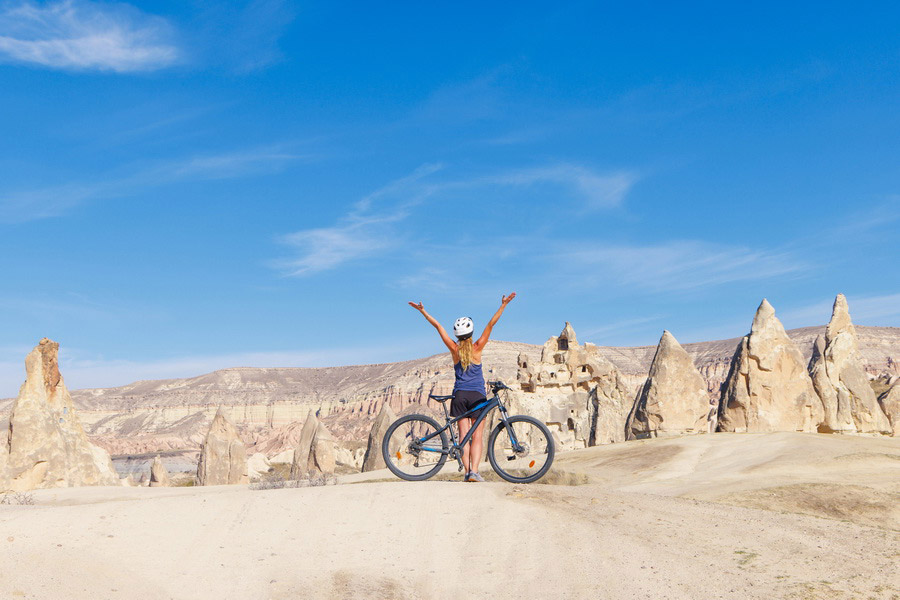
The main Cappadocia attractions can be toured over two full days, but for hikers who enjoy venturing off the beaten track, 3 to 5 days is ideal. It is helpful to understand that there is no autonomous region like "Cappadocia." The term refers not to the entire historic area but only to its tourist parts—the Göreme National Park and surrounding villages.
Göreme is the centre of Cappadocia and the travel base for exploring the entire region. Several marked hiking trails, traditionally called “valleys” (vadisi), are easy to reach on foot. Even from the more remote valleys, independent and solo travellers will have plenty of time to return to Göreme for dinner.
On the other hand, touring the Cappadocia region with a guide is a smart idea if you want to pack as much sightseeing into your trip as possible. A guide can take the guesswork out of planning your Cappadocia travel itinerary to suit your preferences.
Jeep safaris, horseback riding, and biking tours can all be done in Göreme. In addition, Cappadocia can be seen from the air, with helicopter rides providing a bird’s-eye view of the emblematic landscape. Wine connoisseurs can even embark on a wine tour through the Göreme villages, unveiling local vineyards and small cellars in Uçhisar or Ürgüp. Advantour may create a tailor-made tour for you upon request.
Best Time to Visit Cappadocia
March-May and September-November are the best seasons to visit Cappadocia, thanks to the pleasant weather and sparse crowds. Also, planning a trip before June means beating the high-season hordes.
The Salomon Cappadocia Ultra Tail is held annually every October. The marathon suits novice and experienced runners alike. The 2024 event featured three distances: 119 km, 63.6 km, and 38 km. It’s an excellent way to experience the region’s unique terrain.
Summer is the peak season in Göreme. The days are long and sunny, with temperatures reaching 80 °F (30 °C), and all the tourist services are open. However, it is the destination’s busiest time of the year; the sightseeing spots become crowded, and accommodation options are limited. Yet July is the month for the yearly Hot Air Balloon Festival, when hundreds of balloons of bizarre shapes soar high into the sky.
Winter sees lower demand but cold weather with piercing winds and even snow. While it's easier to get good deals on a hotel, and snow-covered rocks are quite a sight, some track trails might not be accessible, and hot air ballooning is not as frequent as in summer. Nevertheless, December to February is best to avoid crowds.
History of Cappadocia
The history of Cappadocia stretches back to antiquity. Situated at the crossroads of civilisations, the region saw numerous battles. The first verified record about Cappadocia dates to the 18th century B.C., when it was under Hittites. Medes, Persians, and Macedonians conquered the land in the subsequent centuries. For a short period, it was even an independent kingdom of Cappadocia. It became a Roman province in the 1st century A.D. The Seljuks and Ottomans settled in the territory in the 11th century, and Cappadocia eventually became part of modern Turkey.
At the onset of the 3rd-4th centuries, Cappadocia became a refuge for Christians escaping persecution in the central provinces of the Roman Empire. The unique landscape and the possibility of digging caves allowed for the perfect hideaway for small Christian communities, some of which later transformed into large cave monasteries. Christianity prospered in Cappadocia in the 8th-9th centuries, when the Byzantine emperor Leo III Isaurian banned icon worship. Believers carved hundreds of churches into the caves and embellished them with red paint. In the middle of the 9th century, the Ecumenical Council reinstated icon veneration. Some Cappadocian communities, however, didn't accept this. Traditional frescoes depicting saints began to appear in Cappadocia by the end of the 9th century, with the best examples dating back to the 11th century.
What to Do in Cappadocia?
Best Time to Visit Cappadocia
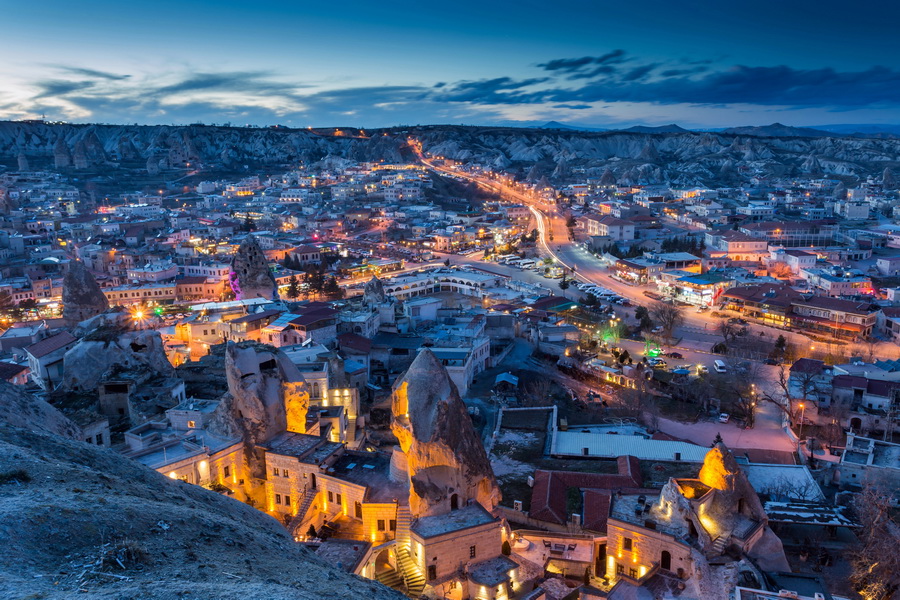
March-May and September-November are the best seasons to visit Cappadocia, thanks to the pleasant weather and sparse crowds. Also, planning a trip before June means beating the high-season hordes.
The Salomon Cappadocia Ultra Tail is held annually every October. The marathon suits novice and experienced runners alike. The 2024 event featured three distances: 119 km, 63.6 km, and 38 km. It’s an excellent way to experience the region’s unique terrain.
Summer is the peak season in Göreme. The days are long and sunny, with temperatures reaching 80 °F (30 °C), and all the tourist services are open. However, it is the destination’s busiest time of the year; the sightseeing spots become crowded, and accommodation options are limited. Yet July is the month for the yearly Hot Air Balloon Festival, when hundreds of balloons of bizarre shapes soar high into the sky.
Winter sees lower demand but cold weather with piercing winds and even snow. While it's easier to get good deals on a hotel, and snow-covered rocks are quite a sight, some track trails might not be accessible, and hot air ballooning is not as frequent as in summer. Nevertheless, December to February is best to avoid crowds.
Landmarks and Attractions
The Anatolian plains will surprise anyone with an unforgettable experience in a lifetime. One of the world's most spectacular topographies, dotted with towering boulders, honeycombed hills, castles, cave churches, and underground cities, the Göreme-Cappadocia region is somewhere that no traveller in Turkey should miss.
However, which highlights should you see in Cappadocia?
Hiking in Valleys

It is no exaggeration to say that the entire Cappadocia consists of valleys. Moreover, the major roads go via plains, making it easy for adventurers to see them on foot.
The #1 valley to visit is the Göreme National Park and its open-air museum. Nestled on the outskirts of Göreme’s centre, the museum captivates with cultural richness, fantastic vistas, and early medieval cave monasteries like St. Barbara Church (Azize Barbara Kilisesi), Apple (Elmalı) Church, Dark Church (Karanlık Kilise), Snake Church (Yılanlı Kilise), and others.
Red Valley (Kızılçukur vadisi) is just a short walk from the heart of Göreme. Spanning 1.5 kilometres, it leads to the lookout point atop the Aktepe hill. The Red Valley funnels into Rose Valley (Güllüdere vadisi), named after the pearl shade of the rocks. Both valleys invite sunset watchers to admire the arrival of the golden hour.
Another amazing walk from Göreme is Pigeon Valley (Güvercinlik vadisi), known for many men-made pigeon houses. The valley draws hikers for its surreal sights, especially from the Uçhisar citadel. Seeing villagers leading camels adds to the charm of the cliffs.
Cappadocia Underground Cities
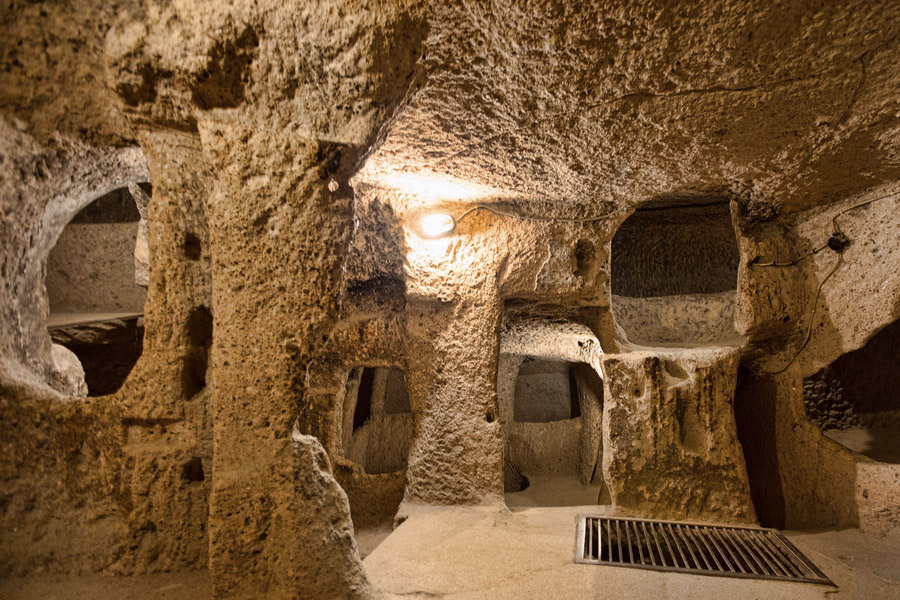
The second most sought-after destinations are underground cities (yeraltı şehirleri). Cappadocia has over 150 subterranean complexes, and archaeologists discover new ones every year.
The Derinkuyu Underground City, the most impressive settlement beneath the earth, could accommodate up to 20,000 people. Before the Christians, escaping from the Arab-Byzantine war and persecution, the town was inhabited by ancient residents of the 8th and 7th centuries B.C. Today, visitors can still tour living and utility rooms, stables, reservoirs, and wine cellars. Derinkuyu’s ventilation system remains functional to this day.
Part of the citadel, the ancient Enegup, and now the Kaymakli Underground City, is another rock-carved marvel. The Phrygians might have dug it into the soft tuff with tunnels connected to the Derinkuyu Underground City. Notably, the city has not yet been fully uncovered, so excursionists are limited to four floors.
Unlike the favoured Derinkuyu and Kaymakli, the Mazi Underground City (Mazı Yeraltı Şehri) is much smaller and has higher ceilings. The tunnels include a central hall, barns, wineries, and a church. One of the advantages of Mazı Yeraltı Şehri is that crowds here are typically thinner.
Castles Near Göreme

Cappadocia castles are fascinating landmarks waiting to be discovered. Visitors can ascend or appreciate them from a distance. Here are the three castles near Göreme.
(Uçhisar Kalesi) is a well-known fortress in Cappadocia. This 60-meter rock formation with cave homes boasts Uchisar Castle stunning views of the Uçhisar surrounding landscapes, including Pigeon Valley. Wayfarers can climb up to the top of the citadel and soak in the serene ambiance. Seasoned tourists recommend visiting the castle in the evening before sunset.
A large and protruding ridge of yellow Swiss cheese-like rock seen for miles around is what is referred to as the Cavusin Castle (Çavuşin Kilisesi). It is the old part of the Çavuşin village, 2.5 kilometres from Göreme. Çavuşin presents cave dwellings, abandoned cafes and hotels, and St. John’s Church. Interestingly, the residents started to leave this part of the city only in the middle of the 20th century.
Ortahisar Castle (Middle Castle/Ortahisar Kalesi) awaits the daring adventurers due to its stunning heights, offering a rewarding climb up its steep stairs. Adrenalin enthusiasts will love it. Rising 90 meters up in the centre of Ortahisar, the citadel affords fabulous views over the town. The illuminated tower in the evening adds to the romantic feel. Thanks to a suitable temperature, many caves in Ortahisar today are used to store fruits and vegetables.
Cappadocia Museums

Apart from the Göreme Open Air Museum, Cappadocia prides itself on a few more.
Pottery lovers should head to Avanos, the centre of ceramic arts in the region.
This small town is renowned for red clay sourced along the Kizilirmak (Red River) banks. Consequently, pottery has thrived here since the time of the ancient Hittites, around 2,000 B.C., and continues to flourish today.
The Chez Galip Pottery Museum displays outstanding ceramics with traditional Turkish floral patterns and blue arabesque spiral motifs. In addition, the studio is home to an eccentric Guiness world record Hair Museum containing thousands of women's locks.
Another favourite museum is the Guray Ceramic Museum (Güray Müze). It caters to an extensive overview of ancient archaeological items, modern ceramics, and the works of illustrious ceramists, including a vast array of Cappadocian artefacts. The museum also focuses on Roman, Byzantine, Seljuk, and Ottoman objects.
In both museums, guests not only have the opportunity to delight in this beauty, but they can also take part in the process—why not try crafting your own unique, one-of-a-kind piece? Furthermore, the museums host souvenir shops, so don’t forget to pick up a keepsake to remember your visit.
Located just 4 kilometres from Avanos lies the Zelve Open-Air Museum, a remarkable monastic complex that dates back to the 9th century. It was home to a Greek population until the 1920s, when a population exchange between Greece and Turkey occurred. As a result, Greek Turks settled in the area. However, 30 years later, concerns over the structural stability of the canyon prompted them to relocate to New Zelve.
Entertainment, Parks, and Shopping
Entertainment
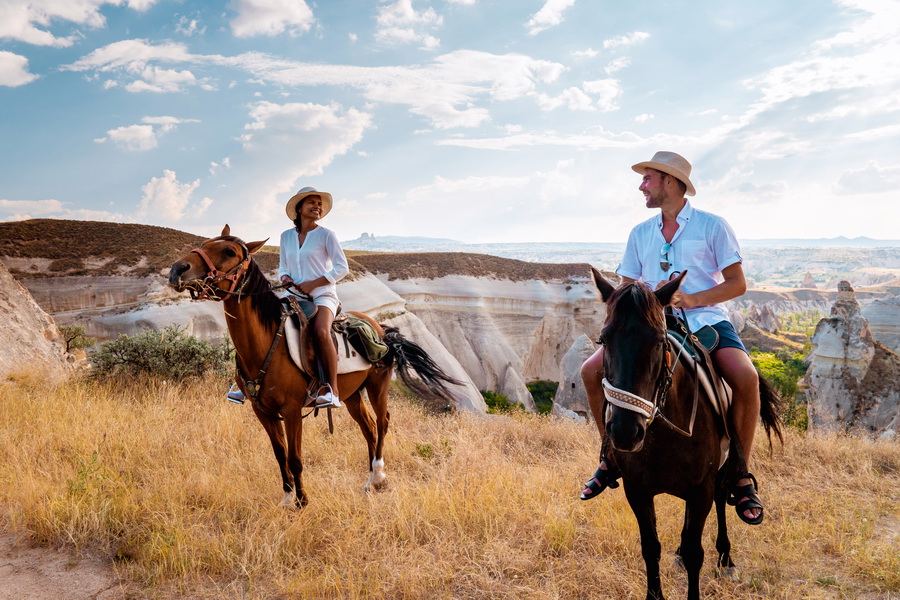
For Cappadocia, hot air ballooning is certainly a king in Göreme. The cavalcade of gently floating balloons in the breeze over the most beautiful and tranquil countryside is a frequent scene on postcards and photos. Newcomers love this adventure because they can see the valleys unfolding and capture gorgeous pictures. Even if you have vertigo, you can still sit on the sidelines and watch the marvellous sight as hundreds of hot air balloons fly at sunrise.
Quad biking is a common way to see Göreme’s curiosities. It’s a fun activity, especially at the start of your journey in Cappadocia. While driving through the vastness of valleys, you'll stop at particular viewpoints to take photos or see the details of caves, exploring the site from a wide angle and in a zoom. You can also rent bicycles and motorbikes here.
And what about getting closer to nature by riding a horse? Many are riding these pretty and docile animals before dawn to catch magical daybreak in the atmosphere of taking off hot air balloons. You can also go hiking, seeing the perspectives of rocks around you changing slowly, step by step.
In the city of Avanos, visitors can get away from the land by taking an exciting gondola tour on the Kızılırmak (Red River).
Ürgüp in Cappadocia is one of Turkey’s well-known regions for producing white wines. So Göreme has no shortage of wine-related activities, including wine tasting.
For a unique twist, attend a pottery or mosaic lamp workshop. It’s an awesome chance to learn about the ancient craft traditions of Turkey.
A visit to a Cappadocian hammam promises the experience of the Ottoman bathing ritual involving cleansing and exfoliation treatment.
Finally, Göreme has a dozen bars and cafes for nightlife seekers. Many are cave inns with Turkish traditional music and dances, like Zeybek, Horon, and Halay.
Parks of Cappadocia
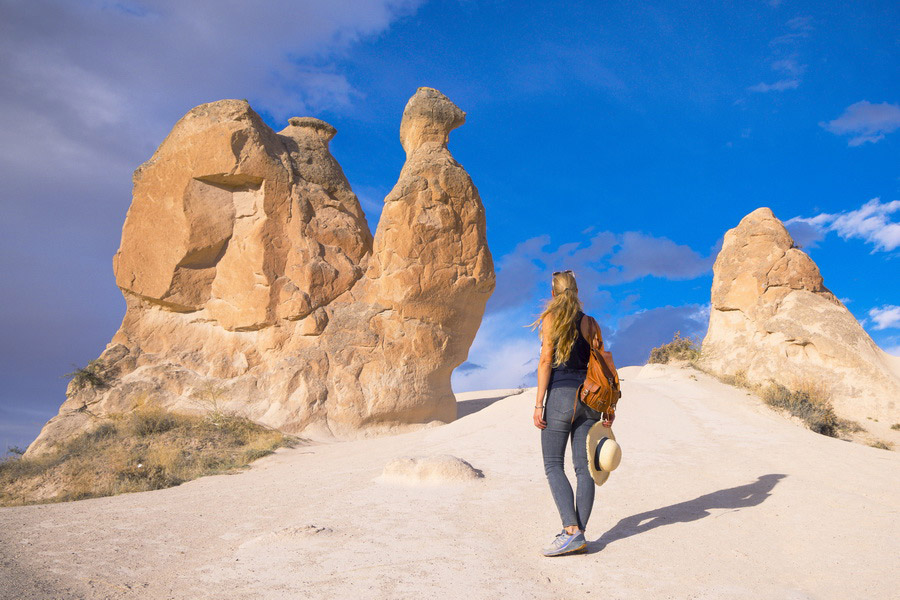
Cappadocia is a vast natural wonder, with a mesmerising parade of valleys, plains, and whimsical rock formations sculptured by centuries of erosion. These unique creations of nature have also served as sanctuaries for thousands during hardship, preserving their lives, history, and culture. So why is not all of Cappadocia a national park? You can walk, explore, eat, relax, and capture stunning photos here. We've already highlighted the must-visit valleys, but there are more gems to add to your Cappadocia itinerary: Love Valley (Aşıklar Vadisi), Sword Valley (Kılıclar Vadisi), Devrent Valley (Devrent Vadisi), Zemi Valley (Zemi Vadisi), Gomeda Valley (Gomeda Vadisi), and Camel Rock.
Shopping in Cappadocia
Cappadocia is a vibrant shopping haven. Shoppers can find various unique items, from exquisite pottery and handcrafted souvenirs to postcards featuring the region's recognisable hot air balloons.
Popular local products include items made from tuff and onyx, as well as culinary delights. Souvenir shops and markets are plentiful in towns like Nevşehir, Avanos, Kayseri, and Göreme. Foreigners can find a widespread amulet (Hamsa), “The Hand of Fatima,” a Turkish tea set, and miniature replicas of balloons and fairy chimneys at small open-air bazaars conveniently located next to key attractions.
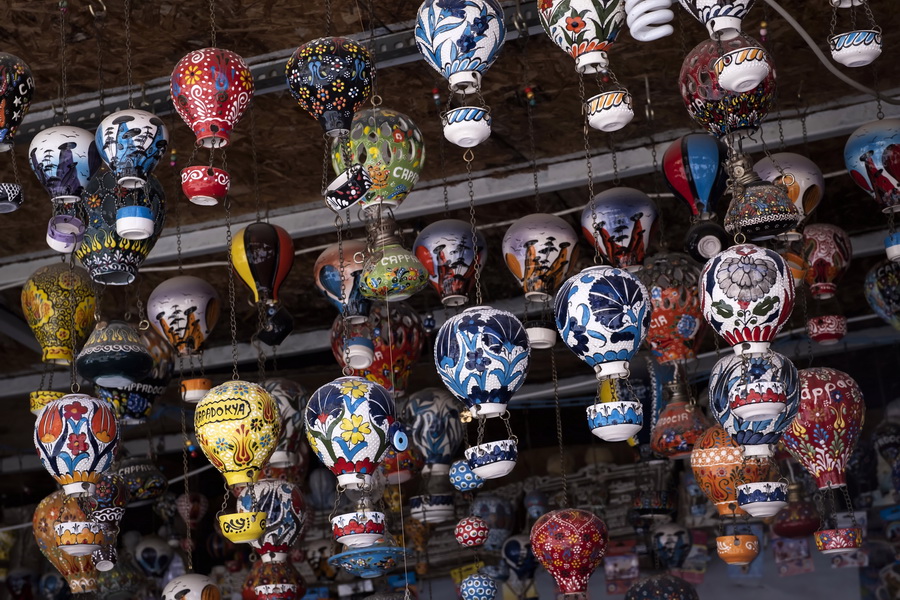
To get ceramics, head to Avanos. But the city is also praised for magnificent carpets. At carpet workshops, you can witness the process of making carpets and perhaps discover the perfect one for your home. Another place for carpets is Kayseri, the country’s oldest carpet weaving centre.
If you are staying in Göreme, stop by the Sultan Carpet store. You can not only discover various carpets but also try on traditional costumes and capture a memorable photo.
Take a closer look at the Soğanlı dolls - handmade rag dolls dressed in traditional attire. They make an excellent gift for doll enthusiasts.
Sending a postcard card to a friend from Göreme, Uçhisar, or Ürgüp depicting Cappadocia's scenic landscape might be a surprise and a heartfelt gesture.
Don’t miss the chance to purchase a bottle or two of Cappadocian wine, crafted from homegrown grapes. You can do this on the spot during wine tasting if you wish.
Turks are known for consuming pekmez (grape molasses) in large quantities due to its health benefits. Other sweets to shop for are halva, pişmaniye, köftür, and dried apricots.
Food in Cappadocia
Visitors will find that the region’s rich flavours and fresh ingredients create a delightful dining experience for everyone.
Turkish Cuisine

You will want to savour the regional cuisine after wandering along the quaint streets of its towns, basking in the Göreme’s sunsets, and exploring captivating cave houses. Here, you can try typical Turkish dishes and authentic Cappadocian recipes.
To truly grasp the region’s culinary passion, begin with the traditional dish in Göreme - testi kebab. This stew, made with meat and vegetables, is slow-cooked in a clay pot. But the real “catch” of testi kebab is not in the ingredients or the cooking process but in the presentation. The waiter brings a sealed clay pot and breaks it open—a truly impressive spectacle!
Where to try testi kebab? One eatery that does have it and a great selection of other delicacies is the Millocal Restaurant Kapadokya.
Another well-liked hot dish in the region is a chickpea stew (etli nohut). The best restaurant to taste etli nohut is Uranos & Sarıkaya. In the evenings, the restaurant hosts a lively dance and music performance, "Cappadocian Night."
No day in Turkey starts without the iconic Turkish breakfast. Whether at a hotel, restaurant, or roadside café, you are sure to be served with many small plates of scrambled eggs, fresh vegetable salad, olives, cheese, jams, and much more.
Gözleme (stuffed flatbread) or börek (flaky dough with different fillings) can be another alternative, as the first thing in the morning or a snack on the go.
Among meze dishes, sarma is a must. These are rolls wrapped in grape leaves filled with a warm, spiced rice mixture.
Vegetarian Restaurants

Although Cappadocia doesn’t have an entirely plant-based restaurant, many eateries still offer vegetarian options. For example, the starters at the Seten Restaurant in Göreme include hummus, roasted red peppers with chickpeas, and fried aubergines. Among their flavourful hot appetisers are oyster mushrooms with mozzarella cheese, soya sauce, and butter. Anatolian Spring Rolls, coming with carrots, courgettes, sweet peppers, spinach, caramelized onion, and spicy tomato topped with mint yoghurt, are also not to be missed.
Coffee Houses, Bakeries, and Patisseries
Cappadocia has desserts to appease your low blood sugar levels at any time of the day, with a cup of Turkish coffee or tea. The top choices here are kuru kaymak (milk waffles), köftür (made from grape molasses), and dolaz (a type of halva).
The Göreme cafes also afford aesthetically pleasing fruit platters that pair harmoniously with the regional Cappadocian wines.
Getting Around Cappadocia
Although the principal attractions in Göreme are easily walkable, perhaps the best means of getting around Cappadocia is a rented car. By having a vehicle, tourists can access the most secluded spots and travel between the towns, thanks to the well-maintained roads and signposts. Major rental companies have a vast presence around the region, including in the two Cappadocian airports. Adventurers can also rent an ATV/QUAD in Göreme for a day.
Foreign visitors are welcome to commute between the cities in dolmuş (minivans), a primary form of transport for denizens. The designated dolmuş stations are in large places like Göreme. They cover routes around the towns and villages. It is the most budgeted way to get around. On the downside, they won’t get travellers off the beaten tracks.
For those looking for a more luxurious ride, Cappadocian taxis are the answer. With a shiny yellow finish, the cabs look quite modern. The transfer can be booked online with Goreme Taxi or hailed from the street.
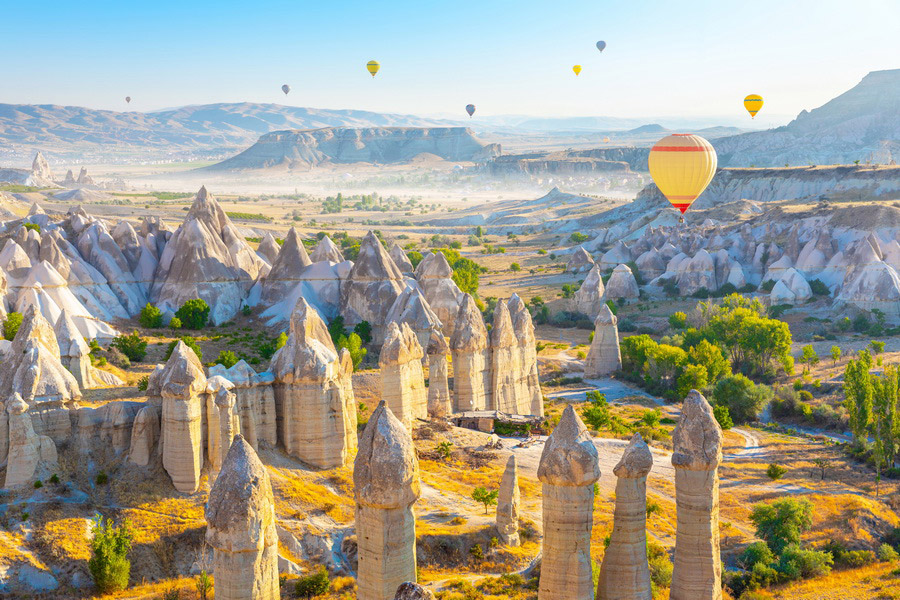
Although more costly than conventional transport, chauffeured car service ensures maximum comfort and convenience. Some hotels may service free shuttles to Uçhisar or Avanos. So, it is always a good idea to check out with your hotel.
How to Get to Cappadocia?
Göreme is about 730 kilometres from Istanbul or 304 kilometres southeast of the capital city of Ankara.
Two airports in the Cappadocia region accept international flights. One is Kayseri Erkilet Airport (ASR)-Erkilet Havalimanı, and the other is Nevşehir Kapadokya Airport (NAV)-Nevşehir Kapadokya Havalimanı.
NAV is the closest airport to Göreme (45 kilometres), operating flights from Istanbul airports only: IST (Istanbul Airport) and SAW (Sabina Gokcen International Airport).
Considered a major airport in Cappadocia, the ASR operates more international and domestic flights. The distance between Göreme and Kayseri Erkilet Airport is 75 kilometres. Minivans from the airport will get you to Göreme in approximately 1 hour and 30 minutes.
During peak season, several European cities, including Amsterdam, Stuttgart, Düsseldorf, Vienna, and others, offer direct flights to Kayseri.
The most convenient way to reach Cappadocia from Istanbul is by plane. Otherwise, a bus ride will take 12 hours. Getting to the region by bus from Antalya requires slightly less time—9-10 hours. Consequently, the fastest alternative is to fly from Antalya to Kayseri.
The best and fastest option between Ankara and Cappadocia is driving or bussing. The road trip takes only 3 hours and 30 minutes.
Languages Spoken in Cappadocia
Cappadocia is part of Turkey, and the official language here is Turkish. Despite this, there's no need to worry if you aren't fluent in the language because many Turks speak at least basic English.
So even if you don't speak Turkish, you can enjoy your trip in Göreme and communicate with the natives. Yet, it never hurts to learn a few key phrases in the local language. To help you get started, here are the most common Turkish phrases:
- Merhaba – Hello
- Günaydın – Good morning
- Teşekkür ederim – I thank you
- Hoşça kal – Goodbye
- Evet – Yes
- Hayir - No
Currency in Cappadocia

As with all of Turkey, the main currency in Cappadocia is the Turkish lira (TRY). Fortunately, credit cards are widely accepted in Cappadocia, particularly in Göreme and around other tourist landmarks.
While many venues take credit cards, visitors need cash or small change for other items. In Cappadocia, they will find plenty of ATMs and banks in Avanos, Uçhisar, and Ürgüp to withdraw cash or exchange currency.
Security in Cappadocia
Cappadocia is generally considered safe for travellers.
Overall, the region offers well-marked trails with plenty of options for different skill levels. On the other hand, newcomers must be well-prepared for hiking to ensure safety and comfort, with proper equipment like sturdy shoes and navigation tools to avoid little mishap. Adequate water and nutrition are vital to staying energized and preventing dehydration during the trek. According to reputable sources like National Geographic and Cave Inn Cappadocia, the most popular trails are regularly frequented by tourists, adding an extra layer of safety.
Cappadocia is widely regarded as a safe destination for solo female travellers. Many women share positive experiences about the local hospitality and low crime rate. Reviews on platforms like Travel Ladies highlight that ladies feel comfortable navigating the area on their own.
While Cappadocia is generally safe, it’s always good to be aware of emergency services. Turkey’s YIMER service, which provides assistance to foreigners, is a valuable resource in case of any need. Travelers can dial 157 for immediate support, including guidance in English. In more critical situations, dialing 112 for emergency services (medical, fire, or police) will connect you with local authorities.
It’s also vital to select reputable operators for hot air ballooning, ATV rentals, and horseback riding. Having special insurance for these activities is advisable.
While Cappadocia is home to some good wines, it is always recommended to enjoy tasting them with moderation, taking into consideration Muslim cultural principles and attitudes towards alcohol.

